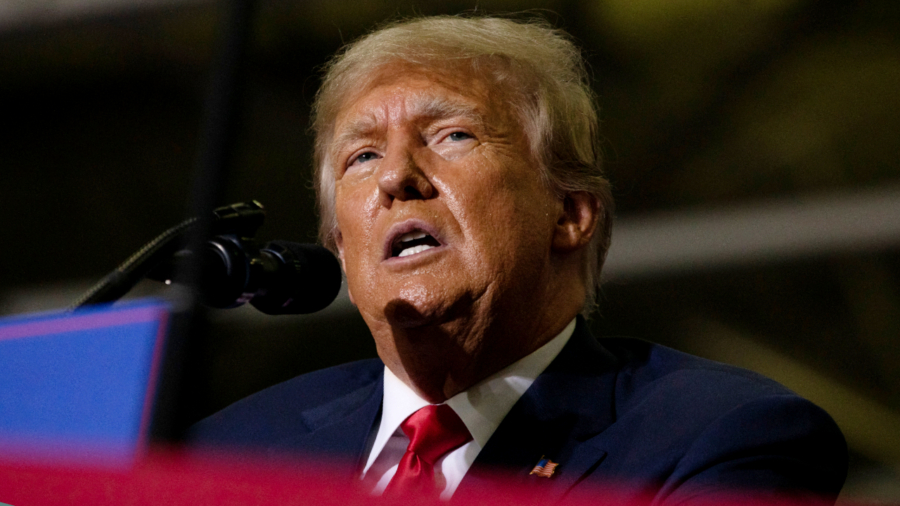Former President Donald Trump on Monday said he “may bring appropriate action” against the Jan. 6 Committee.
The statement, issued through the Save America political action committee (PAC) and shared on Trump’s Truth Social account, came as part of an announcement about a lawsuit he brought against CNN, alleging defamation.
It is unclear whether Trump was threatening to bring legal action against the Jan. 6 Committee, or something else.
A spokesperson for the Jan. 6 Committee did not immediately respond to a request for comment on Trump’s threat.
In his statement on Monday, Trump said of the Jan. 6 Committee: “notwithstanding overwhelming evidence, they REFUSED to investigate the massive Presidential Election Fraud which took place, but only investigate and harass the people and Patriots who complained and asked questions about it.”
He added: “The rigging and stealing of our Presidential Election was perhaps The Crime Of The Century, and look at what is happening to our Country now!”
Trump also said that the committee has “refused to acknowledge” that he had “recommended and authorized thousands of troops to be deployed to ensure that that there was peace, safety, and security at the Capitol and throughout the Country.”
“That offer of National Guard was rejected by Speaker of the House Nancy Pelosi, and Mayor Bowser of Washington, D.C.-the law requires their request, they failed to make one, and in turn failed the Country,” Trump added.
Former Pentagon chief of staff Kash Patel previously noted that Trump authorized up to 20,000 National Guard troops for use in D.C. or elsewhere on Jan. 6, 2021, but the use of those troops was later rejected by D.C. Mayor Muriel Bowser and the U.S. Capitol Police.
Patel explained in an EpochTV documentary published in July called “The Real Story of Jan. 6” that Trump several days before Jan. 6 had authorized as many as 20,000 Guard troops for use on the day. But Bowser and Pelosi rejected the request.
Background
The Jan. 6 Committee was formed after the Democrat-majority House narrowly voted in its favor on June 30, 2021. House Speaker Nancy Pelosi (D-Calif.) had initiated a resolution to create the committee to probe the breach of the Capitol on Jan. 6, 2021.
The nine-member committee has been criticized for its apparent partisanship, in part because the only two Republicans on the panel—Reps. Adam Kinzinger (R-Ill.) and Liz Cheney (R-Wyo.)—are both known for their strong opposition to Trump.
Republican leaders have denounced the Jan. 6 Committee, saying it wasn’t formed according to House rules, because Pelosi had selected Kinzinger and Cheney after having refused to seat Reps Jim Jordan (R-Ohio) and Jim Banks (R-Ind.), who were chosen by House Minority Leader Kevin McCarthy (R-Calif.) to be on the panel.
Rep. Elise Stefanik (R-N.Y.), the House Republican Conference chair, alleged in June that the committee “does not serve any true legislative or oversight purpose.” She had also previously accused the Jan. 6 panel of being a political weapon “used to cover up for Nancy Pelosi’s failures.”
The Jan. 6 committee, on its website, describes Jan. 6, 2021, as “one of the darkest days of our democracy,” when “insurrectionists … launched an assault on the United States Capitol Complex that resulted in multiple deaths, physical harm to over 140 members of law enforcement, and terror and trauma among staff, institutional employees, press, and Members.”

Lawmakers that day had gathered for a joint session of Congress to count and certify the electoral votes related to the 2020 presidential election. It was temporarily interrupted when a sizable group of protesters entered the building and its surrounds. Outside were thousands of other mostly peaceful protesters who had gathered in Washington on the day to express concerns about election integrity.
Trump supporter Ashli Babbitt was determined to have died from homicide on Jan. 6, having been shot and killed by Lt. Michael L. Byrd, a Capitol Police officer.
Another death involved a woman in her 30s, Rosanne Boyland. The D.C. medical examiner ruled her death as an accident from a drug overdose. But video unsealed in December 2021 showed that Boyland was crushed and trampled when the crowd of protesters was pushed out of a tunnel in the Capitol building. She was then repeatedly struck by a police officer as she lay unconscious.
Another three people died of what were ultimately determined to be natural causes that coincided but were unrelated to the protests in Washington and the Capitol breach itself.
One of them was Capitol Police Officer Brian Sicknick who died on Jan. 7; he was initially believed to have died due to injuries caused by protesters but was ultimately determined to have died due to a stroke. The other two people were men in their 50s who died on Jan. 6 due to hypertensive atherosclerotic cardiovascular disease.
As of early October, more than 900 people have been dealt charges by the Justice Department under the Biden administration, accusing them of having committed federal crimes on Jan. 6, 2021. About 400 of them have pleaded guilty. Juries have convicted eight Jan. 6 defendants after trials. None of the defendants who had jury trials were acquitted of any charges.
Joseph M. Hanneman contributed to this report.
From The Epoch Times


